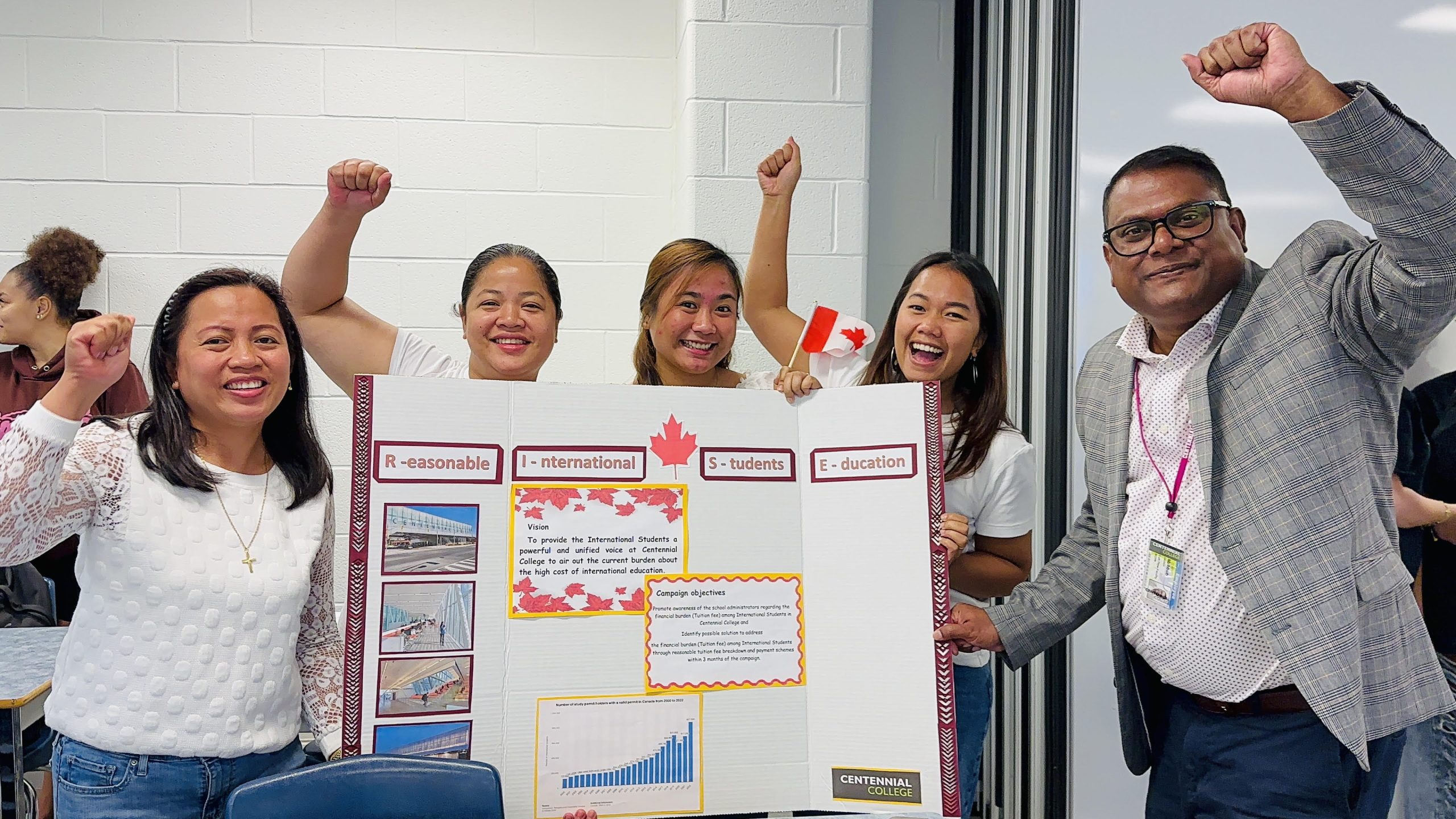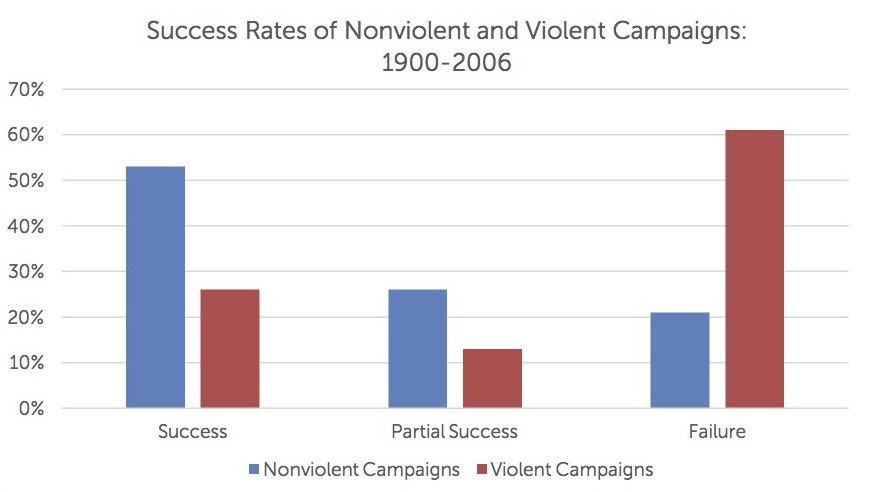2 Chapter 2: Non-Violent Civil Resistance and Social Movements (draft)
Mahbub Hasan
Topics:
- Non-Violent Civil Resistance & Social Movements
- Theories of Social Movements
- Nonviolence Principles
- Examples of Non-violent Resistance/Social Movements: BlackLivesMatter and Civil Resistance in Venezuela
- Types of Power in Movements/Civil Resistance
- Stages of Social Movements
- Theories of Social Movements

Photo caption: A group of students in the Power and Social Movements course at Centennial College designed and displayed a campaign based on nonviolent principles, with their professor, the author of this book, showing solidarity with his fellow students. Photo credit: Dr. Mahbub Hasan, 2023.
Non-violent civil resistance has proven to be a powerful tool for social change. Rooted in the principles of leaders like Gandhi and Dr. Martin Luther King Jr., this form of resistance focuses on active opposition to injustice through love, empathy, and cooperation. By targeting systems of oppression rather than individuals, non-violent movements such as Black Lives Matter have sparked global calls for justice. This chapter explores the principles, characteristics, and stages of social movements, and how civil resistance has contributed to significant societal transformations.
Non-Violent Civil Resistance & Social Movements
Social Movements are ongoing collective efforts aimed at bringing about consequential change in a social, economic, or political order. Movements are civilian-based, involve widespread popular participation, and alert, educate, serve, and mobilize people in order to create change (Hardy Merriman, ICNC regional Institute, 2019).
The practices of nonviolent conflict, following in the paths of Mahatma Gandhi and Martin Luther King Jr, provides social movements with the ideal opportunity because it is based on universal human values and principles -love, empathy, cooperation, and caring (Moyer, 2001).
Nonviolence Principles
Dr. Martin Luther King Jr.’s philosophy of nonviolence, inspired by Jesus Christ and Gandhi, is outlined in his book Stride Toward Freedom. His principles include:
- Nonviolence is an active resistance to evil.
- It seeks friendship, understanding, and the Beloved Community.
- Nonviolence targets injustice, not people.
- It embraces voluntary suffering for a just cause.
- Nonviolence chooses love over hate.
- It believes justice will ultimately prevail.
For further details, visit The King Philosophy.
Here are the principles, characteristics, and goals of nonviolent civil resistance described by Hardy Merriman.
Social movements aim to:
- Change laws
- Change policies
- Change attitudes
- Change culture
- Change power structures
Characteristics of Social Movements:
- Voluntary
- Representative
- Often diverse
The goals of civil resistance can be reformist, such as
- the removal of particular injustice
- the amendment of a particular law/policy
(Source: Hardy Merriman ICNC Latin America Regional Institute 2019. Dr. Hasan Mahbub attended this conference).
Examples of Non-violent Resistance/Social Movements
BlackLivesMatter
#BlackLivesMatter was founded in 2013 in response to the acquittal of Trayvon Martin’s murderer. Black Lives Matter Global Network Foundation, Inc. is a global organization in the US, UK, and Canada, whose mission is to eradicate white supremacy and build local power to intervene in violence inflicted on Black communities by the state and vigilantes. By combating and countering acts of violence, creating space for Black imagination and innovation, and centering Black joy, we are winning immediate improvements in our lives (Source: blacklivesmatter.com)

Caption: Black Lives Matter Toronto, which was invited by Pride Toronto to help lead this year’s parade, brought the procession to a standstill until a list of demands were met. (Mark Blinch/Canadian Press)
Source: CBC News, July 5, 2016.
Civil Resistance in Venezuela
News story title: Mr. Guaidó addressed his supporters in Caracas on Wednesday (May, 1, 2019).
Addressing his supporters in Caracas, Mr Guaidó called the protests an “irreversible process” and vowed to continue demonstrations every day “to achieve freedom”.

Source: CBC News, July 5, 2016.
Types of Power in Movements/Civil Resistance
Let’s review power and its various types as described by Merriman at the Regional Institute in Ecuador in 2019:
In oppressive societies, power flows from the top down, where elites control resources, information, and violence, maintaining an unchanging power structure. In contrast, power from the bottom up is fragile, deriving from consent and obedience, with potential for change. Social movements contest this power dynamic, and the group that is most organized, united, and strategic has the best chance of success in challenging oppressors (Source: Hardy Merriman ICNC Latin America Regional Institute 2019. Dr. Hasan Mahbub attended this conference).
Importance of Non-Violent Social Movements and Civil Resistance
Since 1900, over one hundred major nonviolent movements took place across the world (see graph below), and its frequency and success has been increased over time.

Source: Moyer , 2001
Civil resistance movements have a higher success rate than commonly assumed, though success varies depending on the context.

Source: Erica Chenoweth and Maria Stephan, Why Civil Resistance Works: The Strategic Logic of Nonviolent Conflict, (New York: Columbia University Press), 2011
Research comparing civil resistance to violent insurgencies indicates that nonviolent movements are more likely to achieve major objectives, such as changing governments or ending foreign occupations. While there is no definitive success measure, the evidence points to civil resistance being a highly effective method for challenging authority and bringing about social change (Nonviolent Conflict, n.d.).
For more details, you can visit Nonviolent Conflict.
Types of Social Movements
The following section is adopted from Introduction to Sociology by Lumen/OpenStax, Copyright © 2021 by Lumen Learning & OpenStax, and is licensed under a Creative Commons Attribution 4.0 International License, unless otherwise noted.
We know that social movements can occur on the local, national, or even global stage. Are there other patterns or classifications that can help us understand them? Sociologist David Aberle (1966) addresses this question by developing categories that distinguish among social movements by considering 1) what it is the movement wants to change and 2) how much change they want. He described four types of social movements, including: alternative, redemptive, reformative, and revolutionary social movements.
- Alternative movements are typically focused on self-improvement and limited, specific changes to individual beliefs and behavior. These include things like Alcoholics Anonymous, Mothers Against Drunk Driving (MADD), and Planned Parenthood.
- Redemptive movements (sometimes called religions movements) are “meaning seeking,” are focused on a specific segment of the population, and their goal is to provoke inner change or spiritual growth in individuals. Some sects fit in this category.
- Reformative social movements seek to change something specific about the social structure. They may seek a more limited change, but are targeted at the entire population. Environmental movements, the women’s suffrage movement, or the more contemporary “Buy Nothing Day”, which protests the rampant consumerism of Black Friday, are examples of reformative movements.
- Revolutionary movements seek to completely change every aspect of society—their goal is to change all of society in a dramatic way. Examples include the Civil Rights Movement or the political movements, such as a push for communism.

Figure 1. David Aberle identified these four types of social movements, with some types of movements targeting either specific individuals or everyone, while some want limited changes, and others are more radical.
- Scope: A movement can be either reform or radical. A reform movement advocates changing some norms or laws while a radical movement is dedicated to changing value systems in some fundamental way. A reform movement might be a green movement advocating a sect of ecological laws, or a movement against pornography, while the American Civil Rights movement is an example of a radical movement.
- Type of Change: A movement might seek change that is either innovative or conservative. An innovative movement wants to introduce or change norms and values, like moving towards self-driving cars, while a conservative movement seeks to preserve existing norms and values, such as a group opposed to genetically modified foods.
- Targets: Group-focused movements focus on influencing groups or society in general; for example, attempting to change the political system from a monarchy to a democracy. An individual-focused movement seeks to affect individuals.
- Methods of Work: Peaceful movements utilize techniques such as nonviolent resistance and civil disobedience. Violent movements resort to violence when seeking social change. In extreme cases, violent movements may take the form of paramilitary or terrorist organizations.
- Range: Global movements, such as communism in the early 20th century, have transnational objectives. Local movements are focused on local or regional objectives such as preserving anhistoric building or protecting a natural habitat.
Stages of Social Movements
The following section is adopted from Introduction to Sociology by Lumen/OpenStax, Copyright © 2021 by Lumen Learning & OpenStax, and is licensed under a Creative Commons Attribution 4.0 International License, unless otherwise noted.
Sociologists have studied the lifecycle of social movements—how they emerge, grow, and in some cases, die out. Blumer (1969) and Tilly (1978) outlined a four-stage process through which social movements develop.
- In the preliminary stage, people become aware of an issue, and leaders emerge.
- This is followed by the coalescence stage when people join together and organize in order to publicize the issue and raise awareness.
- In the institutionalization stage, the movement no longer requires grassroots volunteerism: it is an established organization, typically with a paid staff.
- When people fall away and adopt a new movement, the movement successfully brings about the change it sought, or when people no longer take the issue seriously, the movement falls into the decline stage.

Theories of Social Movements
The theories of social movement give us knowledge as to why people organized and joined in campaigns and civil resistance. Let’s watch a video.
Video: Social movements | Society and Culture | MCAT | Khan Academy (7:35)
Direct Link: Social movements | Society and Culture | MCAT | Khan Academy (7:35)
This chapter discusses non-violent civil resistance, focusing on the principles and impact of social movements that aim for change without using violence. It explores the philosophy of nonviolence as practiced by figures like Gandhi and Martin Luther King Jr., highlighting their emphasis on love, justice, and resistance to evil. The chapter also covers types of movements (e.g., reformative, revolutionary) and stages of social movements, from awareness to institutionalization. It provides examples, including Black Lives Matter, and outlines the importance and success rates of nonviolent civil resistance worldwide.
References
- Chenoweth, E., & Stephan, M, J. (2011). Why Civil Resistance Works. The Strategic Logic of Nonviolent Conflict. Columbia University Press.
- Davenport, C. (Eds.). (2005). Repression and Mobilization. Minnesota University Press.
- ICNC. (2019). Civil Resistance. Retrieve from https://www.nonviolent-conflict.org/about/civil-resistance/
- Moyer, W. (2001). Doing Democracy. The MAP Model for Organizing Social Movements. New Society.
- Holmes, Robert L., & Barry L. G, (Eds.). (2005). Nonviolence in Theory and Practice, Second Edition. Waveland Press.
- Mahbub, H. (2015, December 23). Social Movements, Civil Resistance & Human Rights. Dr. Hasan Mahbub.
- NSCC Open Textbook Team. (n.d.). Types and Stages of Social Movements. In Introduction to Sociology 2e. NSCC Open Textbooks. Retrieved from https://pressbooks.nscc.ca/lumensociology2/chapter/types-and-stages-of-social-movements/
- The King Center. (n.d.). The King Philosophy. Retrieved from https://thekingcenter.org/about-tkc/the-king-philosophy/
